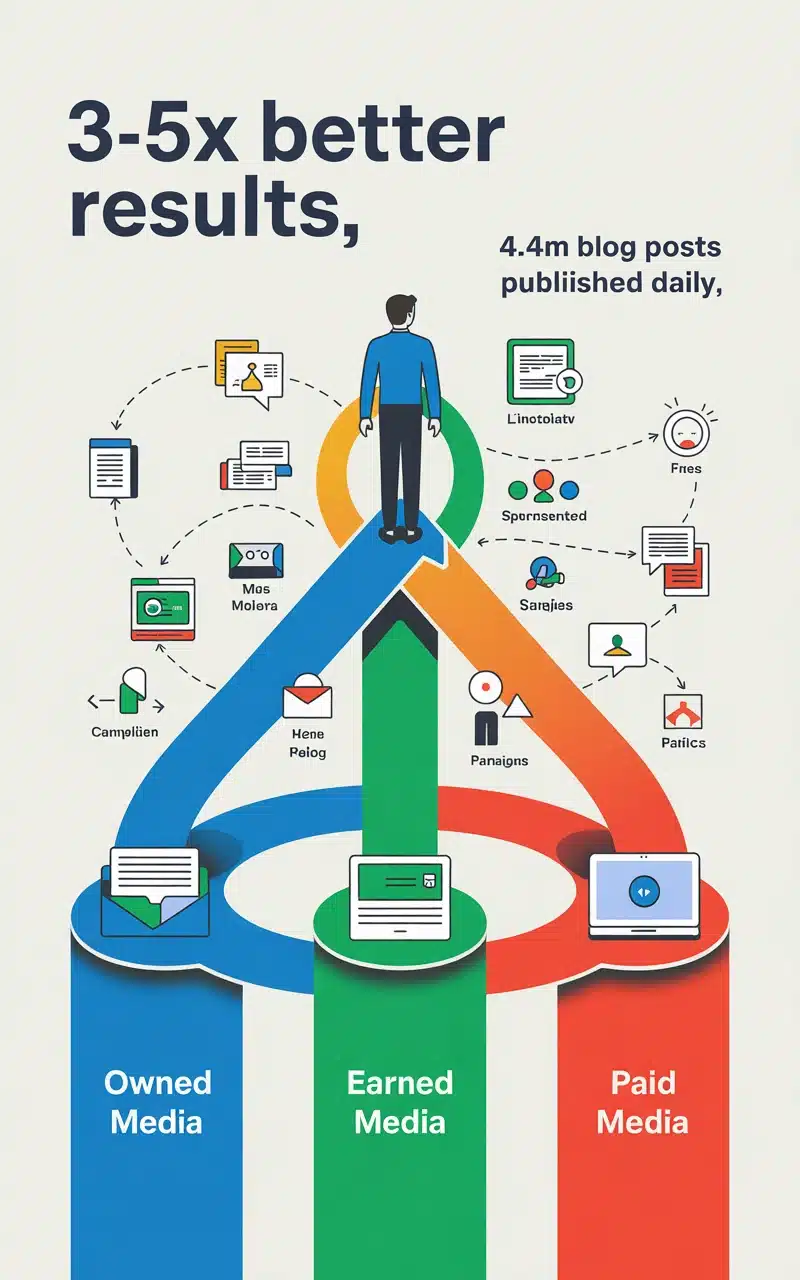
The Technical Guide to Preventing Duplicate Content Penalties in Content Syndication
Do you share your blog posts on other websites to reach more readers? That’s content syndication – a powerful strategy to grow your audience and traffic. But without a proper technical setup, you risk hurting your website’s performance in search results.
This guide shows you exactly how to share your content without facing duplicate content problems. You’ll learn practical steps to protect your original content while still getting all the benefits of wider distribution.
What Is Content Syndication and Why Should You Care?
Content syndication means republishing your articles, blog posts, or other content on third-party websites with permission. It’s different from content theft (when someone takes your work without asking). With syndication, you deliberately partner with other sites to expand your reach.
When done right, sharing your content on other platforms offers several advantages:
- Reaches new audiences who might never visit your website otherwise
- Drives qualified traffic back to your site from readers who want more
- Builds recognition as your content appears on trusted platforms
- Creates new relationships with industry partners and publishers
However, when identical content appears on multiple websites, search engines must decide which version to show in results. Without proper technical signals, they might choose the wrong one – potentially ranking someone else’s copy of your content instead of your original.
The Duplicate Content Problem Explained
When search engines find the same content at different web addresses, they typically:
- Select one version as the “original” to show in search results
- Filter out the other versions to avoid showing duplicates
This filtering isn’t a “penalty” in the traditional sense, but if search engines pick the wrong version as the original, your website loses visibility. Even worse, if they can’t determine which is the primary version, both might receive reduced visibility.
This happens because:
- Search engines can’t always tell which site published the content first
- Larger, more established websites often get preference by default
- Without clear signals, search engines make their best guess about the original
The risk increases when your content appears on websites with more authority than yours. Their version might outrank your original, even though it’s your work.
Technical Solutions: Using Canonical Tags
The most widely used method to prevent duplicate content issues is implementing canonical tags. These HTML elements tell search engines which version of the content is the primary one that should get credit.
How Canonical Tags Work
A canonical tag is a simple line of HTML code placed in the <head> section of a webpage:
<link rel="canonical" href="https://yourwebsite.com/your-article" />This tag tells search engines: “This page is a copy of the content at the URL in the href attribute – please give all ranking credit to that original page.”
Step-by-Step Implementation
- Publish your content on your website first. Always publish on your site before sharing with syndication partners. This establishes your page as the original by timestamp.
- Add a self-referencing canonical on your original page. Your original article should include a canonical tag pointing to itself. Most content management systems add this automatically.
- Provide specific instructions to syndication partners. Send your partners:
- The exact canonical tag to add to their republished version
- A request for attribution with a link back to your original article
- Clear guidance on when they can publish (ideally after your version is indexed)
- Use absolute URLs in canonical tags. Always include your full domain (https://yourwebsite.com/article) rather than relative paths (/article) in canonical tags for syndicated content.
- Verify implementatio.n After your content is republished, check the partner’s page source code to confirm they’ve correctly added the canonical tag pointing to your original.
Real-World Example
Let’s say you write an article “10 Ways to Grow Your Business” on your website ().
When Medium.com republishes it, their page should include:
<link rel="canonical" href="" />And potentially a visible attribution like:
Originally published on Your Business
This setup ensures that search engines understand your version is the original, even as the content reaches Medium’s audience.
Alternative Approaches: When to Use Noindex Instead of Canonical
While canonical tags work well in most cases, sometimes you need stronger protection. The “noindex” directive tells search engines not to include a page in search results at all.
Using Noindex Tags
A noindex tag looks like this:
<meta name="robots" content="noindex" />When added to syndicated copies of your content, it ensures those pages don’t appear in search results, completely eliminating competition with your original.
When to Choose Noindex vs. Canonical
Use canonical when:
- Your syndication partner wants their version to potentially appear in search results
- The partner site adds significant value through comments or related content
- You want to benefit from the partner’s site authority
Use noindex when:
- You need to prevent the syndicated copy from appearing in search
- The partner agrees that their version shouldn’t compete in search results
- You have a close relationship with the partner who prioritizes your success
Important Warning
Never use both canonical and noindex on the same page. These send contradictory signals to search engines:
- Canonical says, “index this other URL instead of this page.”
- Noindex says “don’t index this page at all.”
This confusion can lead to unexpected results. Choose one approach per page.
Best Practices for Safe Content Syndication
Beyond the technical tags, follow these practices to protect your content:
1. Set Clear Partner Guidelines
Create a document that outlines your syndication requirements:
- When they can republish (time delay after your publication)
- Exact code for canonical tags or noindex directives
- Attribution requirements with link placement
- Any content modification restrictions
2. Strengthen Your Original Content
Make your original version more valuable to both readers and search engines:
- Add helpful images, videos, or resources that may not be included in syndicated copies
- Link to your original from other pages on your site
- Share your original version on social media to build initial traffic
3. Be Strategic About Syndication Partners
Not all syndication opportunities are equal:
- Choose partners whose audience aligns with your target market
- Focus on quality sites rather than maximizing the number of republications
- Consider the partner’s website performance and reputation
4. Create Unique Introductions for Syndicated Copies
Work with partners to add unique introductions to syndicated content:
- Helps differentiate the syndicated copy from your original
- Provides context for the partner’s audience
- Adds value beyond simply duplicating content
5. Consider Partial Syndication
Instead of sharing your entire article, consider these alternatives:
- Share a summary or excerpt with a link to read the full piece on your site
- Create a modified version with slightly different content for syndication
- Offer partners a “director’s cut” with additional insights
Measuring Success and Monitoring for Issues
How do you know if your content syndication strategy is working correctly?
Track These Metrics
- Search rankings for your original content. Your original should rank higher than any syndicated copies for relevant searches
- Referral traffic from syndication partners. Check your analytics for traffic coming from sites where your content is republished
- Overall organic traffic growth. Successful syndication should complement, not harm, your search visibility
Regular Monitoring Tasks
- Search for unique phrases from your content to ensure your version appears first
- Check that partners maintain proper canonical tags or noindex directives
- Watch for unauthorized copies of your content
Problem-Solving
If you discover issues:
- Contact syndication partners to correct missing or improper technical implementation
- For unauthorized copies, request removal or proper attribution
- If problems persist with a particular partner, reconsider the relationship
Conclusion: Balance Protection with Promotion
Content syndication offers powerful benefits when done correctly. The technical approaches outlined in this guide help you expand your reach without sacrificing your original content’s performance.
Remember these key points:
- Always publish on your site first
- Use canonical tags to identify your original as the primary version
- Consider noindex when you need stronger protection
- Build relationships with trustworthy syndication partners
- Monitor results and adjust your approach as needed
With these practices in place, you can confidently share your content across multiple platforms, reaching new audiences while maintaining your website’s performance in search results.
Ready to start syndicating your content? Create a simple checklist based on this guide to ensure you follow all the necessary steps each time you share your content with partners.
Grow Your Business – Get More Customers – Learn How it Works!







